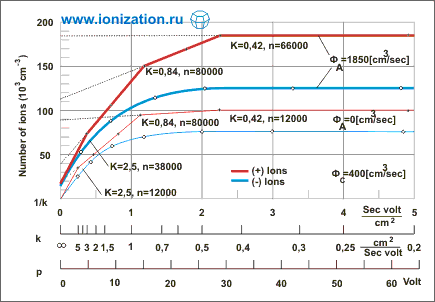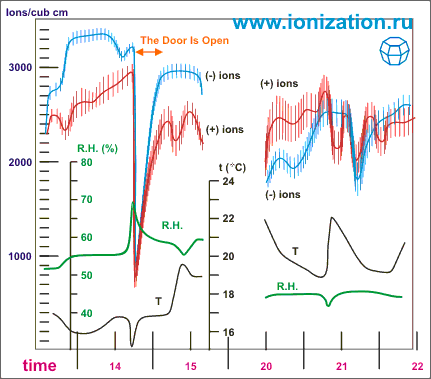Introduction
While studying the works, devoted to air ionization researches, there appeared some changes of research directions from the period of discovery of air ions up to nowadays. On the first stage the appropriate effects were observed in atmosphere air and there were made a number of experimental researches in appropriate conditions. Experimental study of ions in mixture of gases, called air, at atmosphere pressure showed that the observed effects were very complicated and could not be often repeated. On the other hand at lower pressures and in pure gases appropriate effects were observed without any superposition and could be successfully studied. This fact caused the following stage of air ions study, when the measurements were made in isolated vessels at low pressure and in pure gases.
During the measurements in open air there were defined numerous connections between the effects caused by atmosphere air ions and meteorological conditions. However, the ions created artificially at atmosphere pressure turned out to be essential from the point of view of some technical applications (for example, removal of dust particles from the air, removal of electric charges, which were created in some technological processes in industrial production), and also some biological effects (influence on the biological processes and general influence on living conditions of a person and his health).
Artificial creation of air ions
Artificial creation of air ions is necessary for two reasons. First, properties of air ions can be experimentally researched only on condition that the created ions are ions of pure air without mixture of any other products, which usually appear simultaneously with ions that attract our attention. That's why the artificial production of ions is very important for study of their general physical properties. Second, it is necessary for some purposes, especially for research of air ions role in biological processes, as it is important to produce air ions with desired concentration and mobility. As is well known the ions in the air can be produced with the help of different processes. Unfortunately, the most part of theses processes cause the production of some waste products, such as ozone, different oxides of nitrogen, uncharged and charged centers of condensation. (intermediate and large ions).
Fluctuation character of ions density in the air

Over a large period of time there are always changes of ions density as it is showed in the picture. Experiments showed that if air ions were artificially produced in the closed room there were observed high amplitude fluctuations of ions density. So, it was important to take into consideration that the conditions of ions existence in the air had a fluctuation character, regardless of the fact whether ions produced artificially or naturally.
On the picture there are curves of mobility of air ions, which were produced with the help of tritium generator of ions and which were visually measured with the help of suction condenser of Veger and Lindman electrometer. Фс - airflow through the counter, Фа- additional airflow through the distributive chamber, К - maximum mobility in the ion counter, Р - polarizing potential, attached to condenser.

Mobility as the characteristic of air ions. Features of mobility.
To characterize the state of ions in the air it is not enough to get to know just concentration, because features of ions determine the ion features of air. One of these features is mobility. Mobility of ions can be determined; usually the quantity of ions is measured depending on polarizing potential attached to condenser. The characteristic curve for positive ions differs from the curve for negative ions. Characteristic for negative ions is an uninterrupted curve, while characteristic of positive ions is a number of straight lines with breakpoints in special values of polarizing potential. There can be distinguished three groups of positive ions with appropriate mobility 0,42, 0,84 and 2,5 см2 /volt per sec.
Initial and excited states of air.
The same results were got a bit earlier while examining the properties of air ions in our Institute. The results of previous measures gave an opportunity to get a definite idea of air ions properties. In gaseous state the ion was considered as a molecule (or atom), where was the lack of one or more electrons (positive ion) in outer shell, or on the contrary there was one or more additional electrons (negative ion) in outer shell or shells. The ions, which could be called atomic or molecular, could be observed in pure gases at low pressure and they were examined quite well. If such ions were produced in the air at high pressure (for example, at atmospheric), the time of their existence was very short about one part of a millisecond and their mobility decreased. One of the explanations of the mobility decrease was based on the supposition that with the simple monomolecular ion, which appeared in gaseous atmosphere; at high pressures associated other molecules by forming a cluster ion.
Atmospheric ions in the air represented such cluster ions at atmosphere pressure. These small atmospheric, small ions, as they were usually called, could be distinguished into two or sometimes into three groups with different mobility. It was offered to call the ions of first group as initial ions, small ions, and ions of second and third group- excited small ions, because the last ones could be considered as the ions converted from the first group. Based on the above-mentioned measures we could value the mobility of initial positive small ions as 2-2,5 cm2/volt per second, and mobility of excited small ions was 1 and 0,4-0,5 cm2/volt per second.
Changes of ions density on the first floor of Uppsala University

Equally with slow changes there were observed some fast fluctuations of ions density, this area was hatched. Airflow from other rooms polluted with radon and decay products caused the comparatively high level of density. The excess of negative ions, which was observed during some periods of time, could be connected with some processes, where happened the annihilation of negative and positive air ions. It was also indicated the conformity with temperature (T) and relative humidity (R.H.). Open windows and doors caused a drop at 14-30. Measurements were made in April
The article was written by Aydar Tuktagulov from materials of Upsala University (Sapphire Company www.ionization.ru)
THE FULL OR PARTIAL CITATION OF THIS ARTICLE IS FORBIDDEN (write to info@ionization.ru)




